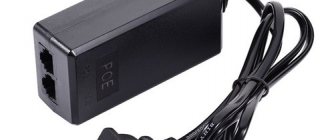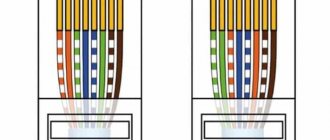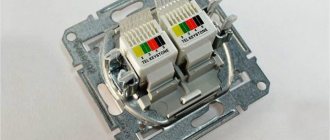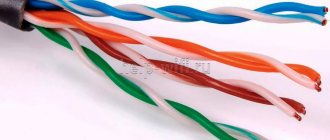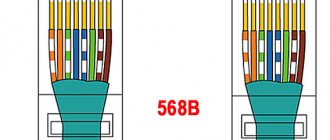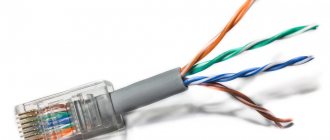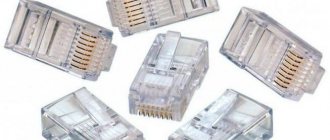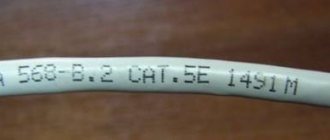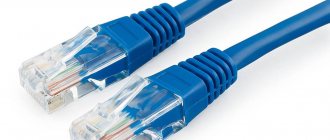Power Line Communication (PLC) technologies have been known to mankind since the first half of the 20th century, although at that time these were telegraph lines that were combined with power lines. After that, when the Internet began to develop, power lines were also used for it, but the speed of signal transmission left much to be desired, and this is perhaps the main reason why this method is not familiar to many people. But, as everyone knows, scientific and technological progress does not stand in one place, and today Internet via an outlet or the Internet through a 220 V outlet allows you to transfer an impressive amount of data, but first things first.
This type of connection has its disadvantages and advantages, which both attract new users and repel its use Source onliner.by
Diameter or cross-sectional area
There is one important point that not everyone is aware of. In the description of the “twisted pair” cable (aka UTP, FTP or F/UTP) and on its packaging it is usually written 4x2x0.51 (sometimes 4x2x0.52). This means that there are 4 twisted pairs in the cable, 2 cores per pair, the diameter of each core is 0.51mm. Diameter, not section!
On power cables (VVG or NYM or KGVV or MKSh) the cross-section is always written, measured in square millimeters, for example, 3x1.5, 5x4 or 2x0.75. And we already have in our heads the typical maximum currents that can flow through such cables, for example, through a cable with a cross-section of 1.5 - 10 amperes, 2.5 - 16 amperes. And it seems that since the twisted pair has a cross-section of 0.51 mm2, then it will withstand a couple of amperes.
But no! Historically, twisted pair cables are designated not by cross-sectional area, but by diameter, because of this, of course, wild confusion arises.
Many sites have written to us with an error that for a twisted pair cable the value 0.5-0.6 refers specifically to the cross-section, and not to the diameter.
PoE cable
The quality of the cable directly determines the quality of PoE and the distance over which it can be carried. The twisted pair must be selected:
- four-pair, not lower than cat.5e,
- copper, not copper-plated (not bimetal),
- with a conductor thickness of at least 0.51 mm (24 AWG),
- with conductor resistance not higher than 9.38 Ohm/100 m (higher values contribute to greater power loss in the cable),
- good manufacturer.
Perfect for a link with PoE, for example:
- Odeskabel unshielded external.
- Odeskabel shielded internal. The possibility of using a shielded cable must be verified according to the manufacturer's specifications. For example, PoE standard 802.3af/802.3at in some MikroTik models is only possible with unshielded twisted pair cable.
What is AWG
Since we're talking about this, you can see the letters AWG on twisted pair cables. This is an American standard describing the diameter of a cable. Moreover, the larger the number written after the letters AWG, the thinner the cable. Here's a simple sign:
In the same plate you can see the relationship between the diameter of the cable core and its cross-sectional area. If desired, the same numbers can be obtained using the formula S = pi * R^2 (section = 3.14 * radius squared). Remember that the radius is only half the diameter.
The most common cable is AWG 24, the diameter of each twisted pair core is 0.51 mm, and the cross-sectional area is only 0.204 mm2.
It turns out that the cross-section of the twisted pair core is extremely small, and the current that can be transmitted through it is also extremely small. In the case of low-current power supply, it is necessary to look not for the maximum current that can be transmitted over a twisted pair so that it does not melt, but for the voltage drop in it. That is, you need to know the cable length, load current and resistivity, then, according to Ohm’s law, calculate the voltage drop in the cable in order to obtain the voltage that will arrive at the powered device passing through the cable. I considered these calculations when I wrote about powering LED strips.
Power over twisted pair: the main thing about Power over Ethernet technology
The technology was created for IP telephony, video surveillance systems and other equipment located, for example, in hard-to-reach places or in areas where there is a shortage of free sockets.
What is it and what equipment supports the technology?
When expanded, the PoE abbreviation looks like Power over Ethernet, which literally means “power over Ethernet.” The technology was created with a view to transmitting electrical energy to a remote device along with data through a regular twisted pair cable.
.
Switches, routers and other active network equipment can be assigned to the role of power supplies in such networks. The receiving side of PoE power is access points, CCTV cameras, IP phones, all kinds of security and service sensors. There are also intermediate links in the chain that allow you to link active PoE equipment with devices that do not support the technology. More on this below.
| There are three PoE technology standards. |
In networks with a bandwidth of up to 100 Mbit/s, data is transmitted over only two pairs of Ethernet cable. Accordingly, the two remaining pairs remain free. They are used to supply remote power in the simplest PoE scheme. In fact, this is not the only option for pinout the wire - it also depends on the standard of power supply technology over the network.
Routers with PoE support MikroTik hAP ac2 from RUR 4,227 MikroTik hAP ac3 from RUR 6,207 Keenetic Voyager Pro KN-3510 from 8,600 rub. MikroTik RB4011iGS+5HacQ2HnD-IN from RUR 20,990 MikroTik hAP ac from RUR 12,590 MikroTik hAP ac lite from RUR 3,086 MikroTik SXT LTE6 Kit from RUR 11,039 MikroTik hAP ac lite TC from RUR 3,086 MikroTik RB2011UiAS-2HnD-IN from RUR 7,822 MikroTik hAP from RUR 2,750 MikroTik RB951G-2HnD from RUR 4,949 MikroTik Audience LTE6 Kit from RUR 17,528 MikroTik wAP ac v2 from RUR 7,820 MikroTik 951Ui-2HnD from RUR 3,677 MikroTik wAP ac from RUR 6,180 Zyxel LTE7490-M904 from RUR 26,438 MikroTik wAP ac LTE6 kit from RUR 13,305 MikroTik Audience from RUR 10,530 MikroTik BaseBox 2 from RUR 5,681 TP-LINK CPE220 from RUR 3,143
PoE Standards
There are three PoE standards:
- IEEE 802.3af
- the first generation of the standard provides power up to 15.4 W for each consumer; - IEEE 802.3at (PoE+)
- provides up to 30 W power to each device; - IEEE 802.3bt (PoE++)
- organizes the supply of power up to 51 W per person. All eight twisted pair conductors are involved in the work.
For the first IEEE 802.3af standard, type A and type B pinouts are provided:
- Type A
- transmission of electricity and data is carried out along cores 1, 2, 3, 6. Cores with serial numbers 4, 5, 7, 8 are not used. - Type B
- cores 4, 5, 7, 8 are used to supply electrical power. Data is transmitted through the rest.
| Variations of Ethernet wire pinout diagrams. |
The second IEEE 802.3at (PoE+) standard uses only scheme B. Visual differences between PoE standards can be seen in the table:
Difference in generations of PoE technology standards
| Characteristics | PoE | PoE+ | PoE++ |
| Powered Device DC Voltage (V) | 36-57 | 42.5-57 | 41.1-57 |
| Source voltage (V) | 44-57 | 50-57 | 52-57 |
| Maximum power of PoE source (W) | 15,4 | 30 | 90 |
| Maximum power received by consumer (W) | 12.95 | 25.5 | 71.3 |
| Maximum current (mA) | 350 | 600 | 960 |
| Maximum cable resistance (Ohm) | 20 (for cat.3) | 12.5 (for cat.5) | 12.5 (for cat.5) |
| Nutrition classes | 0-3 | 0-4 | 0-8 |
In addition, each powered device is assigned a certain class from 0 to 4 depending on the level of power consumption
.
This is necessary for further power control. Distribution of powered devices by class
| Class | Watts per PoE port | Watts per device |
| 0 | 15.4 | from 0.44 to 12.95 |
| 1 | 4.5 | from 0.44 to 3.84 |
| 2 | 7 | from 3.84 to 6.49 |
| 3 | 15.4 | from 6.49 to 12.95 |
| 4 | 30 | from 12.95 to 25.5 |
The network device supplies power to consumers only if the connected equipment supports PoE technology. At the first stage, the powered device is checked, during which a voltage from 2.8 to 10 V is applied to it and the input resistance is determined. If the parameters meet the requirements, the supply equipment proceeds to determine the above classes. After passing through the identification and classification stages, the power supply supplies the cable with a voltage of 48 V with a rising edge no faster than 400 ms.
PoE Switches
MikroTik CRS328-24P-4S+RM from RUR 41,684 MikroTik CRS112-8P-4S-IN from RUR 13,996 MikroTik CRS354-48P-4S+2Q+RM from RUR 73,966 TP-LINK TL-SG1016PE from RUR 13,881 TP-LINK TL-SG1210MPE from RUR 7,161 Ubiquiti UniFi Switch 8-150W from RUR 16,876 Hikvision DS-S908P from RUR 3,782 Ubiquiti UniFi Switch 24-250W from RUR 38,950 MikroTik RB260GSP from RUR 4,578 HP J9984A from RUR 33,538 TP-LINK TL-SG105PE from RUR 3,670 Cisco WS-C2960+48PST-S from RUR 80,907 Ubiquiti UniFi Switch 24-PoE Gen2 from RUR 38,450 Hikvision HiWatch DS-S504P(B) from RUR 2,148 Ubiquiti UniFi Switch USW-Pro-48-POE Gen 2 from RUR 51,480 HP Aruba Instant On 1930-48G-PoE-4SFP+370W from RUR 52,890 Ubiquiti UniFi Switch Lite 16 PoE from RUR 19,125 TP-LINK TL-SG1008MP from RUR 5,505 D-Link DSS-100E-9P from RUR 5,230 Ubiquiti UniFi Switch USW-Pro-24-POE Gen 2 from RUR 65,040
PoE middleware
If it is necessary to include equipment in the network infrastructure without support for power over twisted pair, Passive PoE technology is used. Its integral part is a PoE splitter, which divides the signal incoming via the wire into data and power (12 V-24 V)
. The power indicators in such a scheme will have to be coordinated independently, carefully checking the correspondence of the characteristics of the source and consumer.
The opposite situation also happens when a client device with PoE needs to be connected to network equipment without this technology. In such a scheme, you cannot do without a PoE injector, which has an RJ45 port at the input and a connector for connecting to a power source. At the output it has a single RJ45 connector already with PoE.
| A visual representation of a PoE circuit with an injector and a splitter. |
The intermediate links in the PoE power supply circuit are called Mid-span. Well, devices that supply power from the beginning of the cable line are called End-span.
CCTV cameras with PoE support
Hikvision HiWatch DS-I214WB 2 mm from 4,065 rub. Hikvision HiWatch DS-I259M from RUR 4,546 Hikvision DS-2CD2443G0-IW 2.8 mm from 8,008 rub. Hikvision HiWatch DS-I214WB 2.8 mm from 4,470 rub. Falcon Eye FE-IPC-DP2e-30p from RUR 2,333 Dahua EZ-IPC-D1B20P 2.8 mm from RUR 2,960 Dahua EZ-IP EZ-IPC-D1B40P 2.8 mm from RUR 3,766 Hikvision DS-2DE5432IW-AE from RUR 39,330 Hikvision DS-2CD2423G0-IW 2.8 mm from RUR 7,490 Hikvision HiWatch DS‑I214B 2 mm from 4,083 rub. Hikvision HiWatch IPC-C042-G0/W 2.8 mm from 6,938 rub. Hikvision HiWatch DS‑I214B 4 mm from 4,075 rub. Hikvision HiWatch PTZ-N2204I-D3 from 9,500 rub. Axis P3346 from RUR 2,129 Hikvision DS-2CD2185G0-IMS 2.8 mm from RUR 12,664 Hikvision DS-2CD2463G0-IW 2.8 mm from 10,058 rub. Hikvision HiWatch DS-I214WB 4 mm from 4,400 rub. Hikvision DS-2CD2443G2-I 2.8 mm from 8,206 rub. Axis M1065-L from RUR 25,530 MicroDigital MDC-L3290F from RUR 7,980
Cable Requirements
A separate set of requirements applies to the cable for deploying PoE circuits. They must use twisted pair cable of category 5e and higher. In this case, it is copper conductors that are needed, and not just copper-plated ones. Their thickness should be at least 0.51 mm, and their resistance should be no more than 9.38 Ohm/100 m.
| Twisted pair cables for PoE systems have a special set of requirements. |
The maximum transmission range of PoE power over twisted pair cables is limited to a 100-meter threshold, which is specified in the requirements of the 802.3af and 802.3at standards. However, in practice it is desirable to use cables up to 75 m in length in the case of End-span equipment and up to 60 m in Mid-span circuits. Some advanced switches power consumers over twisted pair cables and at a distance of up to 250 m. A striking example of this is the ZyXel GS1350-18HP switch, which is specialized for ensuring the functionality of video surveillance systems.
Benefits of technology
The key advantages of PoE technology can be highlighted in separate points:
- Connecting powered devices in hard-to-reach places.
- Power management
(relevant “remotely” when you need to restart frozen equipment or devices after the “arrival” of a package of fresh updates). - Electrical safety
(for PoE the maximum voltage is 57 V). - Simplified maintenance
(technicians will have to tinker with the circuit less in case of problems). - The aesthetic side of the issue
(perfectionists will appreciate the absence of unnecessary wires).
The technology also has disadvantages: higher cost of network equipment, the notorious drop in power over long distances of power transmission, requirements for the necessary qualifications of operating personnel.
The beauty of Power over Ethernet is that it uses a single set of wires to carry data and supply power. As a result, the installation of twisted-pair powered systems is significantly simplified and savings can be achieved on the cost of power cables and other components of the deployed network.
Bus cables
If we have a CAN or RS485 or KNX bus spread throughout the premises, and devices that are powered by it hang on the bus, then we need to carefully consider the choice of cable for the bus. If we connect a dozen Wirenboard sensors to one bus up to 60-70 meters long, then there will be no problems, since the current consumption is small and the line length is short. If we transfer the bus to some kind of intermediate shield in which the modules are located, then it is better to install a separate power supply in this shield for reliability. Well, in the general case, you can use something thicker rather than twisted pair for power transmission. For example, KPSVEV 2x2x0.75 has a fair cross-sectional area of each core of exactly 0.75mm2, that is, 3.7 times more than a twisted pair. Accordingly, the voltage drop is 3.7 times less. But the cable is also much thicker. And there were fewer spare veins.
Special interface cables for RS485 usually also have a small cross-section; their core diameter is usually about 0.6-0.8 mm. They are not designed to supply a large number of consumers on a bus.
Special cables for the KNX bus usually have a diameter of 0.8 mm.
For KNX devices, it should be noted that the current consumption is extremely small, a few microamps. Some devices require a separate 24 volt power supply, for example, large touch panels; power can be supplied to them using a separate 2x0.75 cable.
Pinout types
For 802.3af standard
Type A. Both electricity and data are supplied through cores 1, 2, 3, 6. Cores 5, 7, 8 are not used.
Type B. Cores 4, 5, 7, 8 are used to supply power. Data is transmitted through the rest.
For 802.3at standard
Only type B . The use of type A pinout is prohibited by the standard.
For Passive PoE:
In most cases, power supply is carried out on conductors 4, 5, 7, 8 (as in Type B of the 802.3af standard).
(picture enlarges by clicking).
There is also a third type of pinout, when all the cores of a standard four-pair cable are used to supply power, but it is less common, usually in proprietary PoE implementations, for example, UPOE from Cisco.
If you install equipment supporting 802.3af/802.3at standards on both sides of the network, then the type of pinout actually does not matter, since the PoE consumer device can work with any of them according to the standard. However, if we are talking about combining equipment of different standards, this can be important.
Don't buy cheap twisted pair cable
I warn all clients - do not buy cheap twisted pair cable! It’s very cheap - it’s less than 10-12 rubles per meter. The very cheap ones say CCA, which means that the cores are not made entirely of copper, but copper-plated. The copper one says CU (cuprum!).
Next we look at the diameter. 0.46 is undesirable, 0.51 is desirable. It seems that the difference is small, but it affects the quality of the cable.
What is a low-quality cable? This is the kind that you plug into a switch and the wire breaks. Moreover, at the very exit of the vein from the wall, that is, this vein no longer exists. This is the most unpleasant situation. It is recommended to use cables from such manufacturers as Lapp, Hyperline, Legrand, Cavel. Even if the cable turns out to be expensive (50 rubles per meter), but in critical construction sites problems may arise due to low-quality cable, the cost of solving which will be much higher than the cost of the cable.
If it is possible to buy a cable in a coil of not 305 meters (again, the American standard is 100 feet), but 500 or 1000 meters, then there will be less scraps.
There is no need to use a category 6 or even 7 cable to transmit signals (unless you need a 10-gigabit network); a higher category does not automatically mean higher quality. A category 6 cable is more rigid than a category 5 cable and is less convenient to install into a low-current cabinet. If category 6 computer network cables are inserted into a switch in a low-current cabinet without a patch panel, then it will be very difficult to bend them so that they go into the switch and allow the cabinet lid to close.
21, total, today
Related posts:
- Selection of Wirenboard equipment and system design I’ll tell you a little about how to design a Smart Home system on…
- Cable installation for a Smart Home As I already wrote, the most unreasonable way to save money in construction...
- Connecting powerful LED strips There are a lot of subtleties in connecting LED strips. That's just a huge amount...
- Cables for LED strips LED strips have already become an integral part of the interior. They allow you to create...
- RS-485 Modbus in Smart Home systems Modbus in Smart Home systems In wired automation systems Smart…
- Dimming lighting from a Smart Home Let’s touch on the topical issue of dimming lamps from the Smart Home system, especially...
- Terminal blocks for low-current cables Everyone decides which terminal blocks to install for low-current cables...
PoE length
According to the 802.3af and 802.3at standards, the cable length for PoE is stated to be 100 meters. However, in practice, the maximum length of a PoE twisted pair cable depends on many factors, including previously unknown ones:
- conductor cross-sections,
- metal conductors,
- number of bends on the line,
- interference, uneven characteristics of twisted pair cables, cable kinks, etc.
With a discount for kinks and other things, the maximum length of the PoE cable is preferably no more than 75 meters. However, with a really high-quality cable, the same Odeskabel, for example, you can make a larger span.
If we are talking about Passive PoE, then the length can be shorter, up to 30-60 meters. The line calculation must be carried out taking into account:
- what voltage does the powered device need (including at peak load),
- what voltage does the source produce?
- what is the resistance of the twisted pair and, accordingly, what will be the voltage loss on the line.
